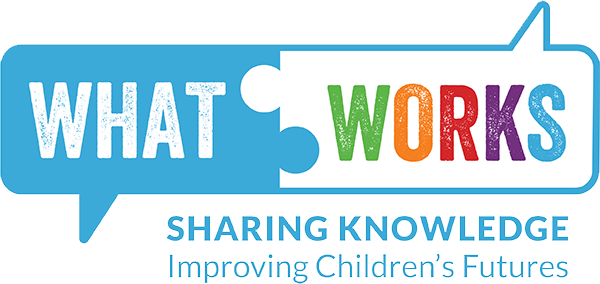Families and Schools Together Preschool

Families and Schools Together (FAST) Preschool is a group-based intervention for parents of a preschool child who wish to support their child and become more engaged in their community. It can operate at a universal level, but is more frequently provided on a targeted basis to families where there is an elevated risk of child behavioural problems.
Parents and children attend eight weekly sessions delivered by teams made up of representatives from the community, including previous group members alongside professionals. Weekly meetings include a shared meal, 15-minute play session, family communication activities and parent discussion from which parents learn how to manage their stress and their child's behaviour.
EIF Programme Assessment
Child outcomes
This programme can affect outcomes for children in Active and healthy, physical and mental wellbeing.
According to the best available evidence for this programme's impact, it can achieve the following positive outcomes for children:
Preventing crime, violence and antisocial behaviour
Improved behaviour (parent-report)
based on study 1
This programme also has evidence of supporting positive outcomes for couples, parents or families that may be relevant to a commissioning decision. Please see About the evidence for more detail.
Who is it for?
The best available evidence for this programme relates to the following age-groups:
Preschool
How is it delivered?
The best available evidence for this programme relates to implementation through these delivery models:
- Group
Where is it delivered?
The best available evidence for this programme relates to its implementation in these settings:
- Children's centre or early-years setting
- Primary school
- Community centre
How is it targeted?
The best available evidence for this programme relates to its implementation as:
- Universal
Where has it been implemented?
- Australia
- Canada
- England
- Northern Ireland
- Scotland
- United States
- Wales
Ireland provision
Ireland evaluation
About the programme
What happens during the delivery?
How is it delivered?
- FAST is delivered in eight sessions of 2.5 hours’ duration each by teams made up of representatives from the community, including previous group members, alongside professionals with QCF level 6/7. It is delivered to groups of families and children, typically in which an elevated risk of child behavioural problems has been identified.
What happens during the intervention?
- FAST Preschool is a group-based intervention for parents of a preschool child who wish to support their child and become more engaged in their community.
- Weekly meetings include a shared meal, 15-minute play session, family communication activities and parent discussion.
What are the implementation requirements?
Who can deliver it?
- This programme is delivered by teams made up of representatives from the community, including previous group members, alongside professionals with NFQ level 7/8/9.
What are the training requirements?
How are the practitioners supervised?
What are the systems for maintaining fidelity?
- Training manual
- Other printed material
- Other online material
- Video or DVD training
- Face-to-face training
- Supervision
- Accreditation or certification process
- Booster training
- Fidelity monitoring
Is there a licensing requirement?
There is no licence required to run this programme.
How does it work? (Theory of Change)
How does it work?
- Parent–child attachment and family relationships reduce conflict in the family and improve child behaviour at home and at preschool.
- FAST Preschool aims to improve family communication and strengthen parent’s bonds with their child, each other, their preschool and their community.
- In the short term, FAST parents/carers have increased confidence and increased involvement in preschools and their communities. Children will be better able to self-regulate.
- In the long term, the benefits of FAST Preschool impact on the home through better relationships and parental engagement in their child’s early education. Later on in life, this will result in improved school attendance and educational attainment. In addition, children will be less likely to misuse substances, and engage in antisocial behaviour.
Intended outcomes
Contact details
Carol Goedken
CEO
FAST non-profit organisation
cgoedken@familiesandschools.org
About the evidence
Families and Schools Together (FAST) Preschool’s most rigorous evidence comes from a pre/post study which was conducted in the US.
This study identified statistically significant positive impact on a number of child and parent outcomes.
A programme receives the same rating as its most robust study, which in this case is the McDonald et al. (1998) study, and so the programme receives a Level 2 rating overall.
Study 1
| Citation: | McDonald et al. (1998) |
| Design: | Pre/Post |
| Country: | United States |
| Sample: | 80 families |
| Timing: | Post-test |
| Child outcomes: |
|
| Other outcomes: |
|
| Study rating: | 2 |
McDonald, L., Payton, E., Sayger, T., & Whitfield, H. (1998). Increasing protective factors for mental health in Head Start children through outreach and multi-family FAST groups.
Study design and sample
The first study is a pre-post study.
The study was a pre-post only study. Outcomes were assessed before the intervention was delivered and six months after the intervention was delivered.
This study was conducted in the US, with a sample of 80 families with primary-school-aged children.
Measures
Family cohesion was measured using the Family Environment Scale (FES) (parent report) and the Family Adaptation and Cohesion Scales (FACES III) (parent report). Family conflict was measured using FES (parent report).
Child behaviour was measured using daily reports, and the Child Behavior Check List (CBCL) (parent and teacher report). Child internalising and externalising behaviour were measured using the CBCL (parent and teacher report).
Findings
This study identified statistically significant positive impact on one child and parent outcome, respectively.
In relation to child outcomes, there is evidence of improved behaviour.
The conclusions that can be drawn from this study are limited by methodological issues pertaining to a lack of a comparison group.